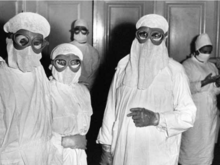1963 smallpox epidemic in Wrocław
You can help expand this article with text translated from the corresponding article in Polish. (December 2022) Click [show] for important translation instructions.
|
| 1963 smallpox epidemic in Wrocław | |
|---|---|
 Protective clothing worn by health workers during the epidemic | |
| Disease | Smallpox |
| Virus strain | Variola vera |
| Location | Polish People's Republic |
| Index case | A public officer returning from India (or another Asian country) |
| Dates | 17 July - 19 September 1963 |
| Confirmed cases | 99 |
Deaths | 7 |
An outbreak of smallpox occurred in the city of Wrocław in Poland in the summer of 1963. The disease was brought to Poland by an officer in the Ministry of Public Security who had returned from India. The epidemic lasted for two months, causing 99 people to fall ill and seven to die. It caused Wrocław to close and quarantine itself.[1][2]
It was one of the last smallpox outbreaks in Europe (the 1972 Yugoslav smallpox outbreak was last)[3] and the biggest disease outbreak in Europe until the COVID-19 pandemic.[4]
Poland started vaccination against smallpox in 1919 and eradicated it in 1937.[5]
Patient zero
[edit]The officer who brought the virus was a lieutenant colonel, Bonifacy Jedynak. He had returned from Delhi, India on 22 May 1963 and became infected by an unknown disease. He went to the hospital of the interior ministry in Wrocław where he was diagnosed with malaria. Meanwhile, smallpox was transmitted to a nurse who had mild symptoms and was believed to have chickenpox.[6][4] Her son, daughter and the attending doctor were infected and died later.[4]
Progress of epidemic
[edit]
Lonia Kowalczyk was the first person who died because of the infection.[7] On 15 July 1963, an anti-epidemic emergency was announced in the city, 47 days after the first case of the disease. 10,000 vaccines were delivered from the Polish capital Warsaw that day. Around 1 million vaccines were delivered from Soviet Union and from Hungary. Vaccination was mandatory from 1 August 1963. The non-stop vaccination centre was at Wrocław train station. The campaign took 2 months.
The initial estimate of WHO was that the epidemic would last for two years with 2,000 deaths. Thanks to fast response and availability of vaccination, the epidemic was suppressed and it was officially ended on 19 September 1963. 8.5 million people were vaccinated in total.[4]
References
[edit]- ^ "Epidemic in Wrocław in 1963". Institute of National Remembrance. 18 March 2020.
- ^ "SMALLPOX BATTLE WIDENED IN POLAND". The New York Times. 27 July 1963. ProQuest 116618718.
- ^ Żuk, Piotr; Żuk, Paweł (24 September 2019). "One of the recent attacks of smallpox in Europe: A massive vaccination campaign during the epidemic in Wrocław in 1963". Vaccine. 37 (41): 6125–6131. doi:10.1016/j.vaccine.2019.08.038. PMID 31455585. S2CID 201654865.
- ^ a b c d "Jak socialistické Polsko zvítězilo nad epidemií pravých neštovic". A2larm (in Czech). 2021-01-30. Retrieved 2024-01-12.
- ^ Majmurek, Jakub (2021-01-26). "Obowiązkowe szczepienia i cała władza w ręce lekarzy. Jak PRL uporał się z epidemią". KrytykaPolityczna.pl (in Polish). Retrieved 2024-01-12.
- ^ Jasińska, Joanna (5 April 2020). "Lockdown and isolation: the summer a Polish city defeated an outbreak of one of the world's deadliest diseases". The First News.
- ^ Rosalak, Maciej (21 October 2020). "Wrocław w szponach zarazy. Miasto zostało odcięte od reszty kraju" [Wrocław in the grip of a plague. The city was cut off from the rest of the country]. Historia Do Rzeczy (in Polish).
